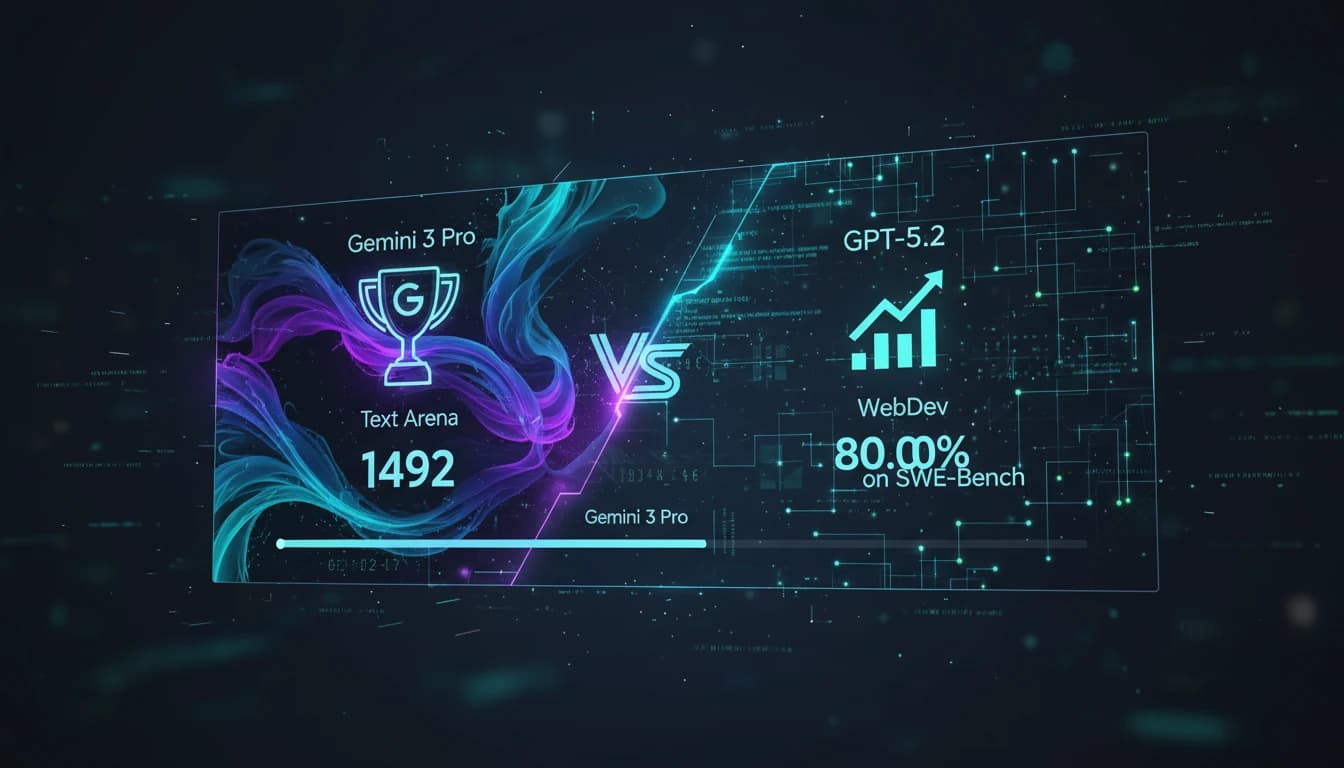LMArena: How the Web’s Most-Watched LLM Leaderboard Works in 2025
FREEIt’s 6:40 p.m. and your release train leaves tomorrow.
Two models are neck-and-neck—but one crushes long prompts while the other shines on code diffs. You open LMArena, run 20 real prompts across Overall → Coding → Longer Query, then try your repo in RepoChat. By 7:15 p.m., the pattern is obvious: route by task, note the trade-offs, and ship with confidence.
What LMArena is (in 60 seconds)
LMArena (ex–Chatbot Arena) is a public leaderboard where people compare LLM answers head-to-head. Each anonymous vote updates an Elo-style rating. It’s ideal when you need to choose a model for a task (coding, web dev, long prompts, etc.) and want a human-preference signal—not just static benchmarks.
How it works (1-minute version)
- Anonymous battles: two models answer the same prompt; you vote before names reveal.
- Arena Elo: votes update ratings; leaderboard also shows MT-Bench and MMLU panels to triangulate quality.
- Only battles move Elo: Side-by-Side is for labeled comparison; it doesn’t affect scores.
Snapshot: who’s on top today
Scores shift frequently. Treat tiny gaps as noise and re-check if you’re publishing.
Text Arena — Aug 21, 2025
| Rank | Model | Score |
|---|---|---|
| 1 | gemini-2.5-pro | 1457 |
| 1 | gpt-5-high | 1455 |
| 1 | claude-opus-4.1-20250805-thinking-16k | 1451 |
| 2 | o3-2025-04-16 | 1445 |
| 3 | chatgpt-4o-latest-20250326 | 1442 |
| 3 | claude-opus-4.1-20250805 | 1439 |
| 3 | gpt-4.5-preview-2025-02-27 | 1439 |
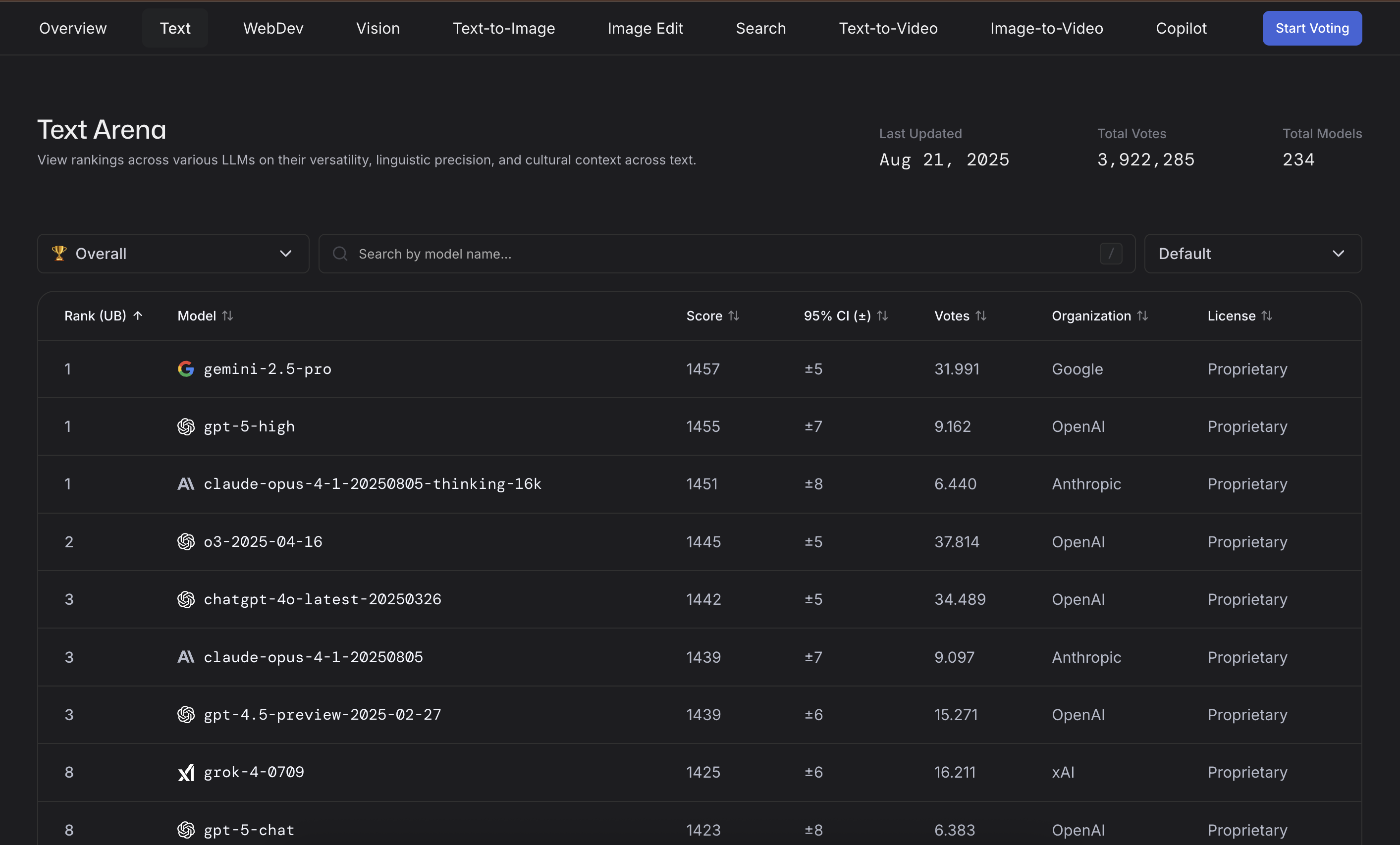
- Gemini 2.5 Pro’s rise (Text & WebDev). Google announced Gemini 2.5 Pro with stronger reasoning/coding in March 2025 and rolled it into Google AI Studio/Vertex AI by early summer.
WebDev Arena — Aug 22, 2025
| Rank | Model | Score |
|---|---|---|
| 1 | GPT-5 (high) | 1481 |
| 1 | Claude Opus 4.1 thinking-16k (20250805) | 1474 |
| 3 | Claude Opus 4.1 (20250805) | 1436 |
| 4 | Gemini-2.5-Pro | 1405 |
| 4 | DeepSeek-R1-0528 | 1392 |
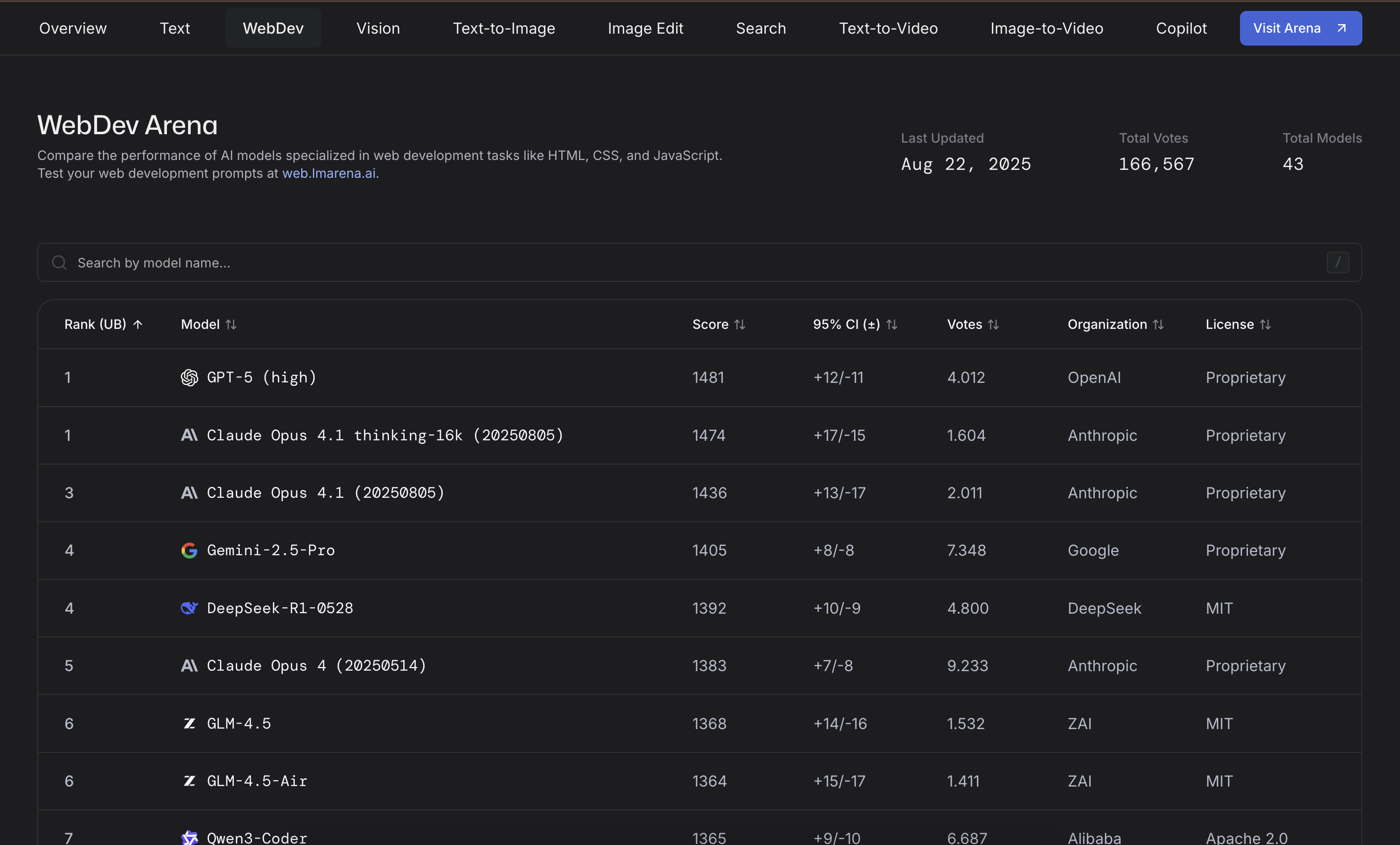
- “GPT-5 (high)” label in WebDev. LMArena’s WebDev tab currently lists a model labeled GPT-5 (high) at #1 with a tight confidence interval—useful for shortlisting. Details beyond the label aren’t formally blog-announced by the vendor, so treat the leaderboard entry as an observed performance tag rather than a marketing name.
Copilot Arena (coding assistants) — May 29, 2025
| Rank | Model | Score |
|---|---|---|
| 1 | Claude 3.5 Sonnet (06/20) | 1012 |
| 1 | Deepseek V2.5 (FiM) | 1028 |
| 1 | Claude 3.5 Sonnet (10/22) | 1004 |
| 1 | Codestral (25.01) | 1001 |
| 1 | Mercury Coder Mini | 994 |
| 1 | Qwen-2.5-Coder (FiM) | 998 |
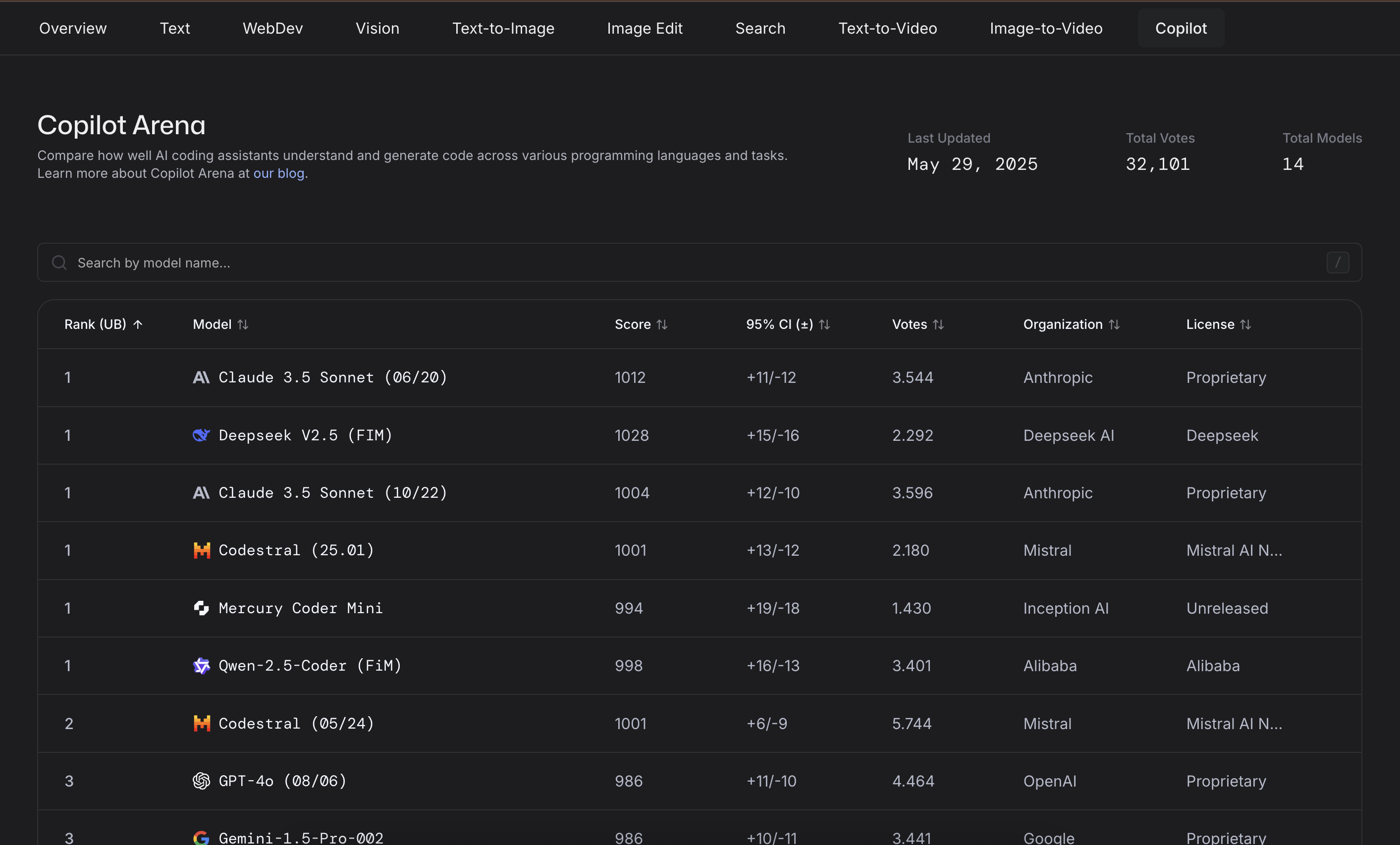
DeepSeek’s momentum. DeepSeek’s R1 (Jan 2025) and its May update focused on reducing false outputs and improving complex reasoning. That dovetails with appearances like DeepSeek-R1-0528 in WebDev leaderboard slots and DeepSeek V2.5 (FiM) surfacing in Copilot Arena. Media coverage also noted its cost/performance story driving broad adoption interest
Claude Opus 4.1 (Aug 2025) and “thinking-16k.” Anthropic’s Opus 4.1 release on Aug 5 highlights upgrades for agentic tasks and real-world coding; the thinking-16k variant showing at the very top of WebDev Arena matches that narrative. Expect stronger multi-step reasoning and long-context edits to keep it competitive.
Takeaway: Recent model releases (Gemini 2.5 Pro, Opus 4.1) and updates (DeepSeek R1-0528) explain much of the movement near the top. Use the news to form hypotheses—then battle on your prompts to validate before you route in production.
Read this before you over-index on tiny gaps
- A ±5–15 Elo difference near the top is often noise—break ties with your prompts.
- Category flips happen: a top-3 overall model can drop on Coding or Longer Query.
- Opponent effects: who you fight changes Elo; don’t treat it like an absolute IQ score.
Three ways to use LMArena (hands-on)
1) Direct Chat — fast single-model sanity check
Use when you want one good draft quickly (tone/style, first pass).
Paste this prompt to try:
You are an AI assistant helping a software team. The team needs to decide whether to use retrieval-augmented generation (RAG) or fine-tuning for adapting a large language model to their domain (technical documentation + support tickets).
Write a concise recommendation memo (~250 words) that:
- explains pros/cons of both (clarity, cost, speed, maintenance),
- gives a final recommendation with reasoning,
- ends with Next steps bullets.
Make it clear enough that a CTO could decide in 5 minutes.
What to look for: structure, trade-off clarity, actionable next steps.
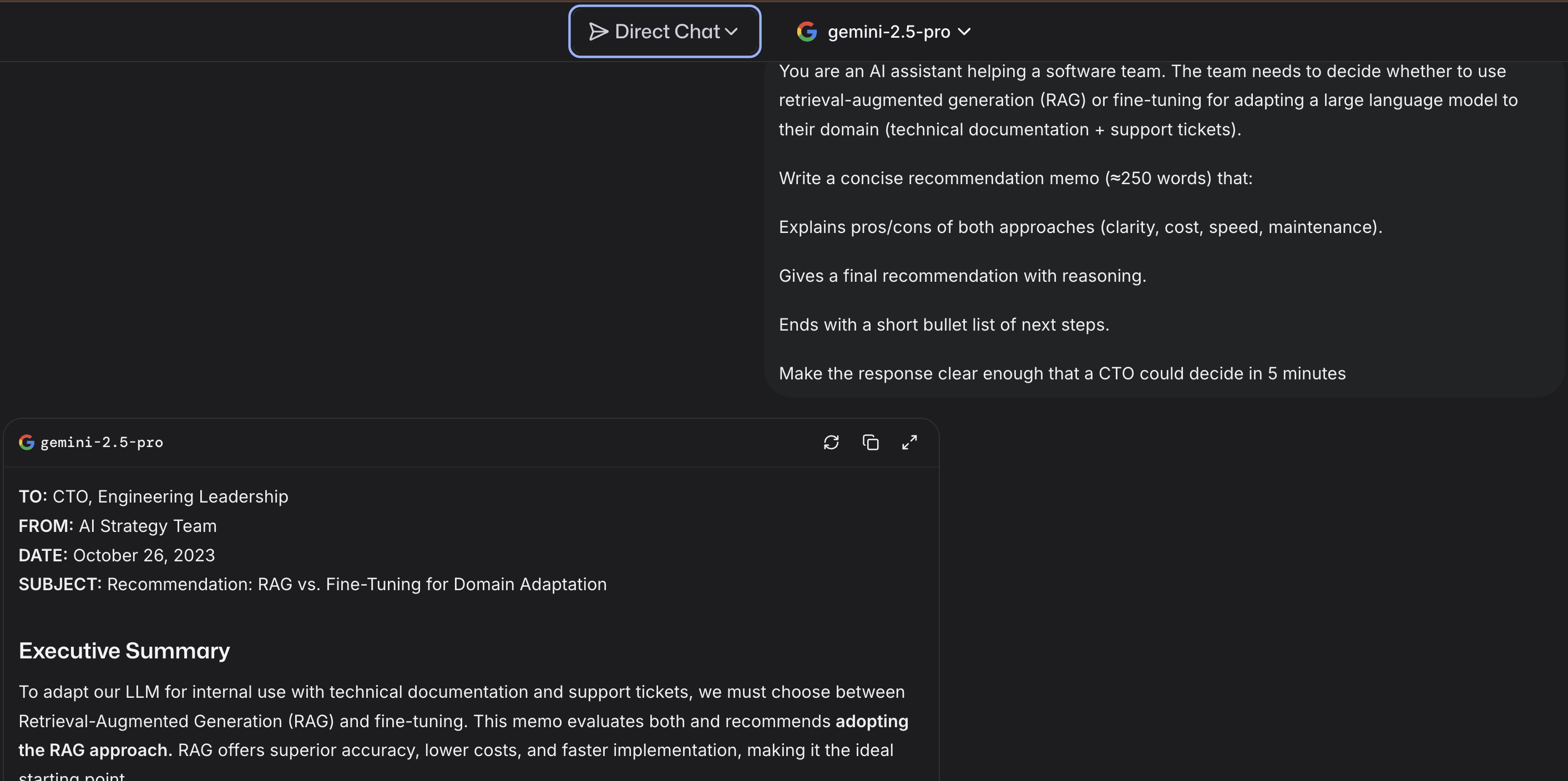
2) Battle — anonymous A vs B (you vote after reading)
Best when you’re deciding between two candidates and want blind judgment.
How to run a good battle
- Paste a real prompt from your backlog.
- Read both answers before names reveal.
- Vote for the one you’d ship to a user today.
Quick rubric: correctness → reasoning → instruction-following → conciseness → citations (if any).
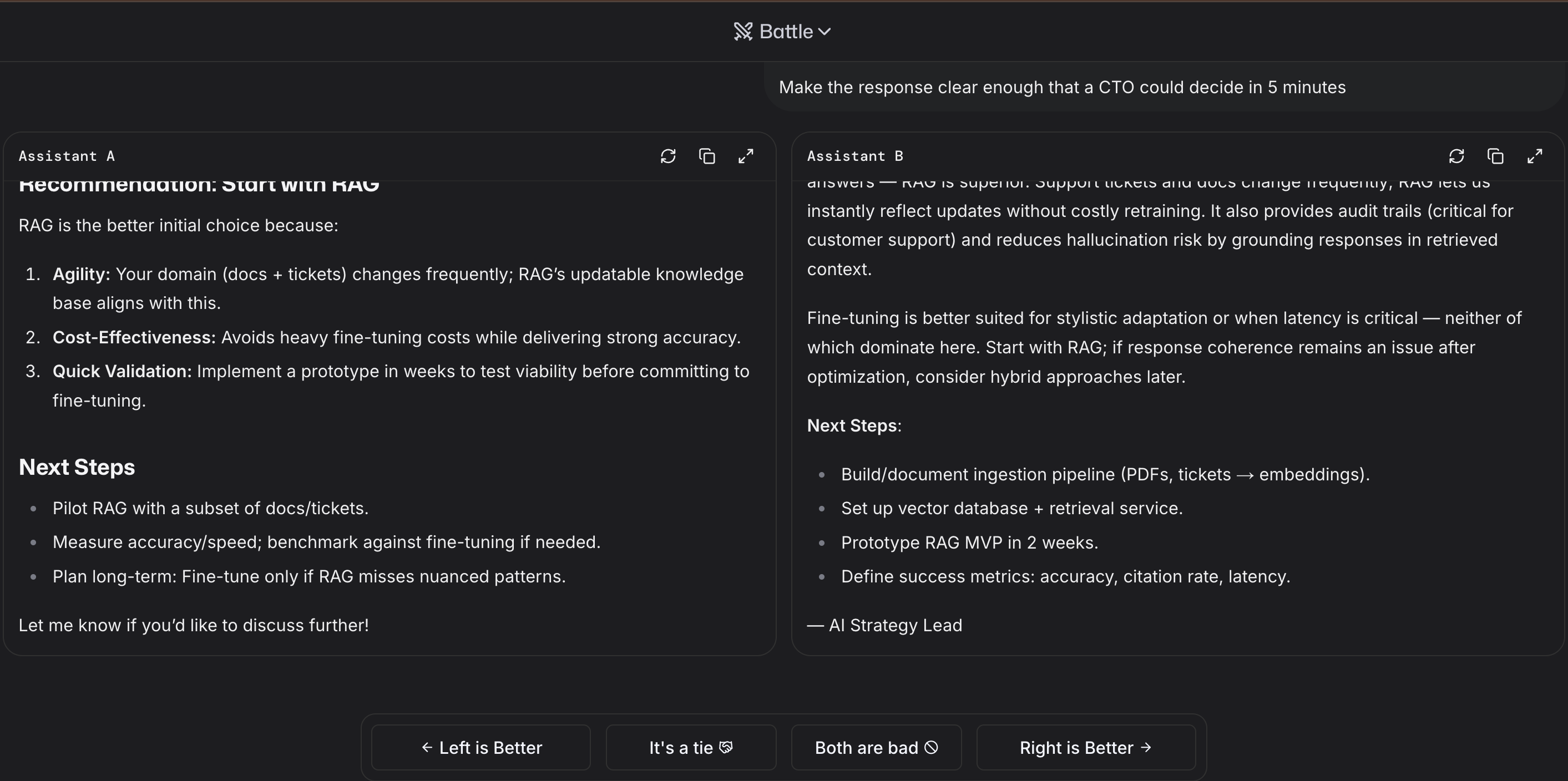
3) Side-by-Side — explicit model vs model
Pick two finalists (e.g., gemini-2.5-pro vs gpt-5-chat) for a labeled comparison.
Tips
- Keep the same prompt across runs to compare apples to apples.
- Do 5–10 prompts per task (long spec, coding bug, data wrangling).
- Note failure modes: latency spikes, hallucinations, messy formatting.
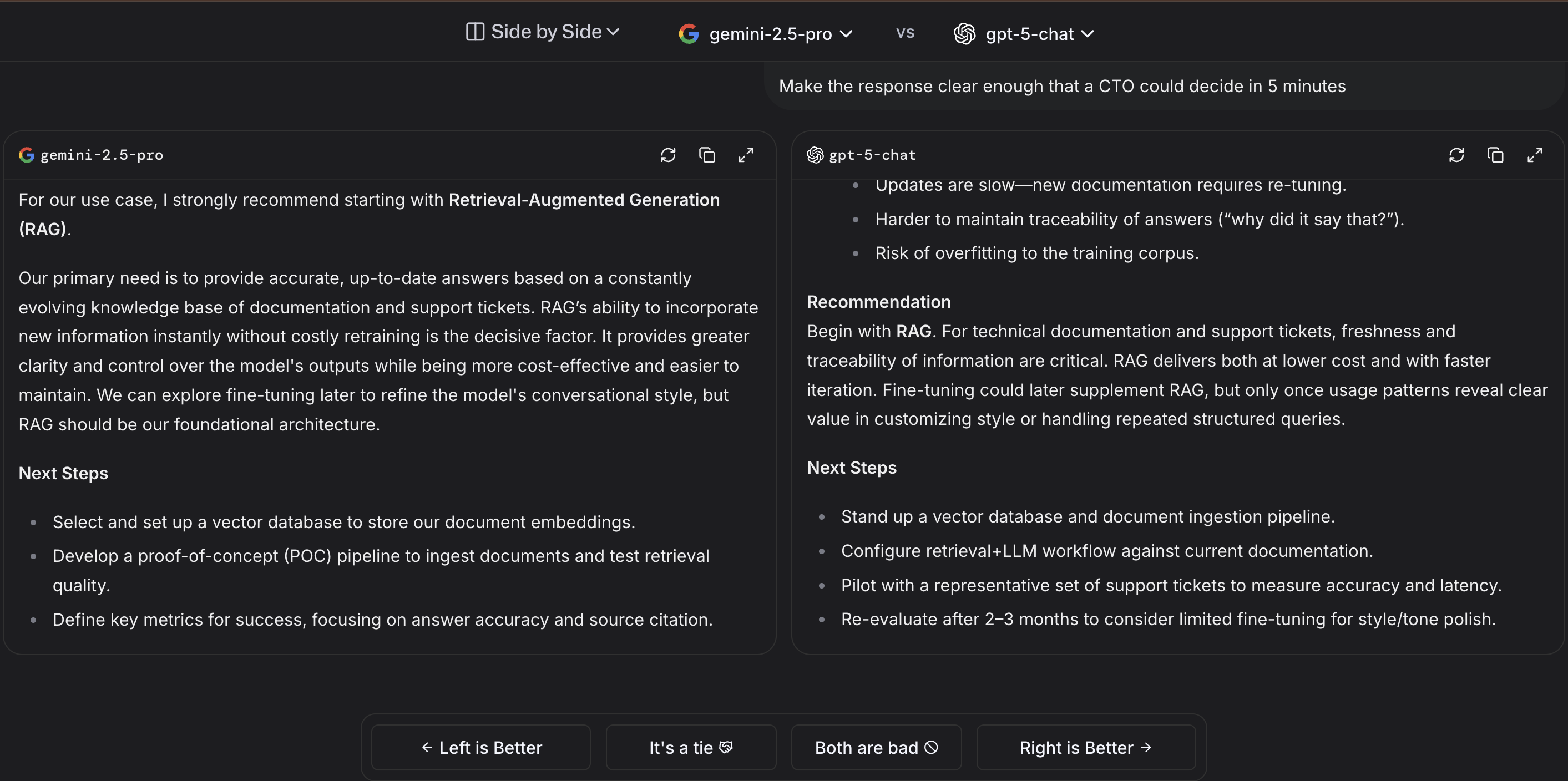
How to read the leaderboard without overfitting
- Start with the right tab. If you ship front-end code, WebDev matters more than Text “Overall”.
- Triangulate. Elo is human preference; cross-check the MT-Bench/MMLU panels shown next to rows.
- Beware tiny gaps. A few points at the top are often noise—use battles on your prompts to decide.
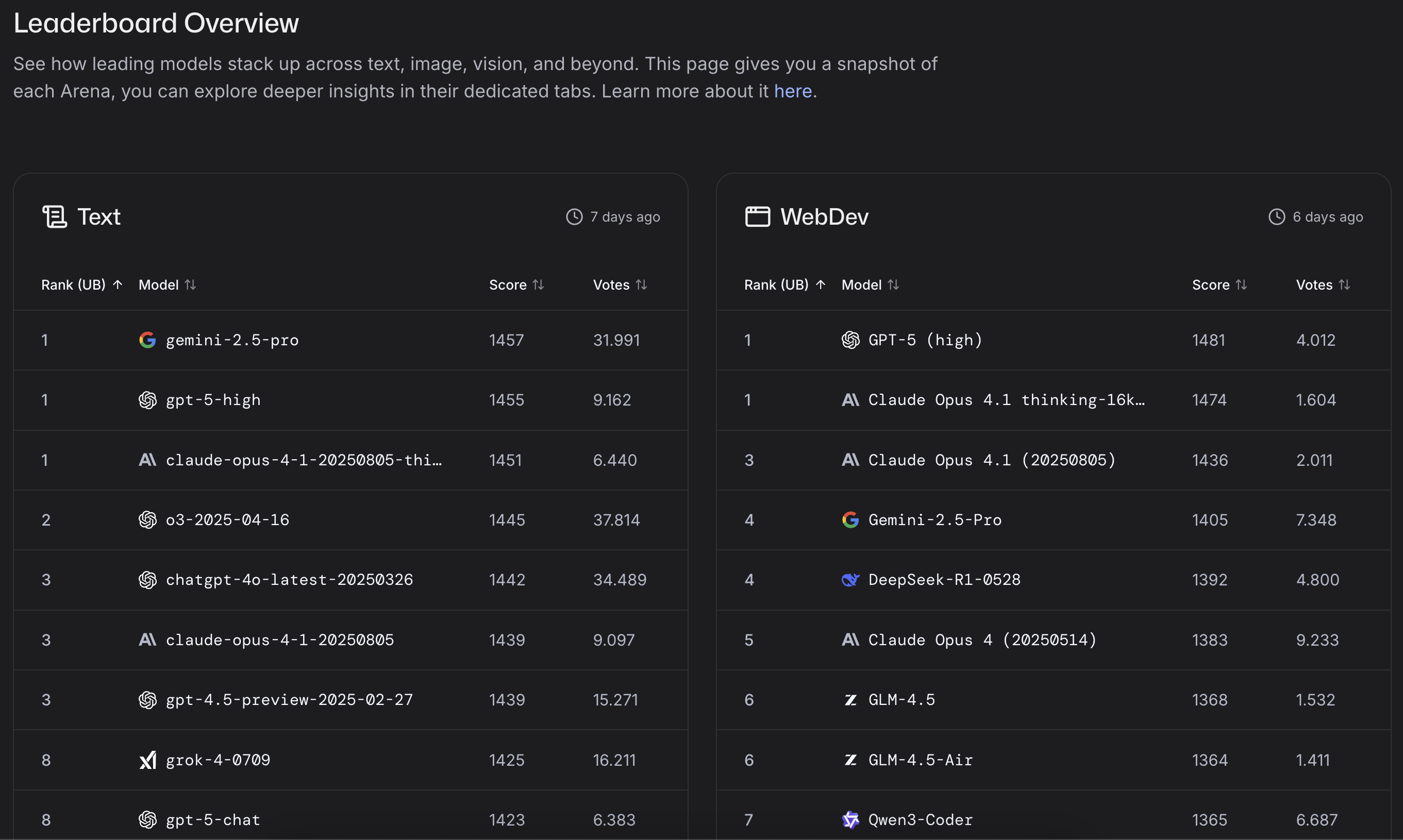
A 20-minute evaluation recipe (teams)
- Collect 6–8 real prompts (2 coding, 2 long-form, 2 domain-specific).
- Shortlist 3 models from the relevant tab.
- Run 10 battles total (shuffle pairs).
- Record winners + notes (reasoning, latency, formatting).
- Pick per-task winners; route in prod by task if needed.
Lightweight monthly health-check
- 6 prompts × 3 categories (Coding, Longer Query, Your Domain)
- 6–10 battles per category vs last month’s winner
- Log: win rate, latency, formatting, citation quality
- Update your router only if deltas persist across two checks
Curiosity bites
- Side-by-Side ≠ Elo: SxS is labeled for audits; only anonymous battles change ratings.
- Repo-aware surprises: average overall models can win in RepoChat on your codebase.
- Latency matters: ask raters to flag when answers are “too slow to be useful.”
Caveats & privacy
- Human preference ≠ ground truth. Treat Elo as one signal; verify with your tests/benchmarks.
- Small Elo deltas are noisy. Break ties with your own prompts.
- Privacy: treat LMArena as public—don’t paste sensitive data.
Don’t pick a single winner—pick a routing plan
Run 10–20 arena battles per task type, compare Overall + Category Elo with MT-Bench/MMLU, and keep a lightweight rubric (correctness, latency, citations/tool-use). If the top two are close, prefer the one that wins your failure cases. Re-check monthly; model drift is real.
FAQ
Tip: Each question below expands to a concise, production-oriented answer.
What exactly is LMArena?
A public, anonymous, pairwise arena where humans vote on better answers; an Elo-style system turns those votes into a live leaderboard.
Is Elo just “who sounds nicer”?
It’s a preference signal. Use it with MT-Bench/MMLU and category filters to avoid style-over-substance traps.
Which model is #1 right now?
It changes. Check Overall, then your category; small Elo gaps are noise—validate on your prompts.
Are my prompts private?
Treat them as not private; don’t paste sensitive data.
Why do teams use LMArena?
To de-risk launches, route by task, detect regressions, tune prompts/guardrails, and validate cost–performance trade-offs on real prompts.
Is Elo reliable on its own?
It captures human preference, not ground truth. Triangulate with MT-Bench, MMLU, and category leaderboards, and validate on your prompts.
How do I add my model?
Follow FastChat’s How to add a new model (host your own/3rd-party API or request LMSYS hosting).
Is there recent open data I can analyze?
Yes—July 2025 release of 140k recent text-arena battles, plus Chatbot Arena Conversations (33k) and LMSYS-Chat-1M (1M).




